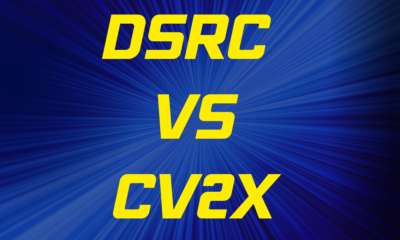Business Solutions
Solo PRO: Outside Broadcast King
Published
1 month agoon
By
Roze Ashley
Ditching the Truck for Agile Live Video
The iconic image of a live broadcast van, a hulking presence at any major event, has for decades symbolized the intricate and often cumbersome nature of bringing live video to audiences from beyond the studio walls. This mobile production hub, bristling with antennae and overflowing with sophisticated equipment, became synonymous with professional outside live broadcasting, representing a significant logistical and financial undertaking. Imagine the cost, the manpower, and the sheer planning required to deploy and operate these mobile behemoths, often limiting truly high-quality live coverage to only the most commercially viable events. Consider the challenges faced by smaller organizations, independent creators, or those seeking to capture spontaneous, real-time moments from locations less accessible to these large-scale operations. Were we to be forever confined by this paradigm, where true broadcast quality demanded the infrastructure of a small village?
But a shift is underway, a quiet revolution that is challenging the very definition of outside broadcasting and empowering a new era of agile, accessible live video production. Technology is advancing at an unprecedented pace, and a key innovator in this space is Solo PRO. This compact yet powerful device is not just streamlining workflows or reducing costs; it’s fundamentally reimagining how live video is created and delivered from remote locations. Picture a scenario where the capabilities of an entire broadcast truck are distilled into a portable unit, capable of delivering pristine, professional-grade live feeds from virtually anywhere, with unparalleled ease and efficiency. This is the promise of Solo PRO, and it’s a promise being rapidly realized across the broadcasting landscape, liberating content creators and ushering in a new age of dynamic, flexible, and truly global live video. Let’s explore the top seven game-changing benefits that solidify Solo PRO’s position as the undisputed “Outside Broadcast King,” and understand how it’s rewriting the rules of live video production for the modern era.
Beyond the Studio
Historically, the term broadcast quality carried significant weight, representing a benchmark of technical excellence and visual fidelity achievable only under tightly controlled conditions. This often meant the sterile environment of a studio or the meticulously engineered ecosystem of a dedicated outside broadcast (OB) truck. Venturing beyond these controlled spaces for live video production often implied a compromise, a trade-off between portability and quality. Broadcasters faced a difficult choice: prioritize mobility and sacrifice some level of visual fidelity, or maintain broadcast quality but remain tethered to cumbersome and geographically limiting setups.
Solo PRO effectively eliminates this Faustian bargain, ushering in an era where “broadcast quality” is no longer geographically constrained. This technology empowers broadcasters to achieve genuinely pristine, high-definition live video transmissions from virtually any location imaginable, effectively breaking free from the traditional limitations of studio-bound or OB-truck-dependent production. Imagine capturing the raw energy of a live concert from the heart of the crowd, streaming breaking news reports from disaster zones in real-time, or broadcasting from the summit of a remote mountain range, all with the visual clarity and professional polish previously reserved for studio productions. Solo PRO makes this a reality.
Its advanced encoding and transmission capabilities ensure that video and audio signals are delivered with exceptional fidelity, rivaling – and in many instances exceeding – the quality traditionally associated with legacy OB methods. This newfound location freedom is not merely a technical achievement; it’s a creative liberation. It allows content creators to tell stories from anywhere, to capture the authentic pulse of events as they unfold, and to connect with audiences in a more immediate and impactful way, unbound by geographical limitations and empowered by true broadcast quality, location agnostic video production.

Unpack & Go Live in Minutes
The traditional outside broadcast workflow was, by its very nature, a time-consuming and logistically complex undertaking. Deploying a full-scale OB truck operation to a remote location was akin to setting up a temporary broadcast studio from scratch. It involved intricate planning, meticulous equipment checks, and a coordinated effort from a large technical team. Consider the hours spent on rigging cameras, running hundreds of feet of cable, establishing power distribution networks, calibrating audio and video feeds, and meticulously testing every connection before the broadcast could even begin. This protracted setup time not only added significant costs to live productions but also rendered traditional OB setups impractical for capturing rapidly evolving events or spontaneous live moments. The window of opportunity for timely live coverage could often close before the setup was even complete.
These remarkably compact units, often smaller than a typical backpack, are meticulously engineered for speed, efficiency, and intuitive operation. Imagine arriving on location, unpacking a Solo PRO unit, connecting a camera, and initiating a professional-grade live stream within mere minutes – a feat that would have been considered science fiction just a few years ago. The streamlined interfaces and intelligently automated configuration features embedded within Solo PRO systems minimize the need for extensive technical expertise or cumbersome manual adjustments. Camera operators, journalists, and even less technically specialized personnel can quickly become proficient in deploying and operating Solo PRO, enabling rapid response and incredibly agile live broadcasting workflows. This dramatic reduction in setup time translates directly into tangible benefits: reduced labor costs, minimized pre-production time, increased responsiveness to breaking news, and the ability to capture fleeting live moments with unparalleled speed and efficiency. Solo PRO empowers broadcasters to be truly agile, reacting swiftly to unfolding events and bringing live video to audiences with unprecedented immediacy and ease.
Reliable Streams, Even on the Move
Signal instability has long been the bane of outside broadcasting, a persistent gremlin that could disrupt live feeds, compromise broadcast quality, and induce constant anxiety in production teams. Traditional wireless links, reliant on single frequencies, are inherently vulnerable to a multitude of environmental factors: atmospheric interference, signal obstructions from buildings or terrain, and network congestion in densely populated areas. Even satellite-based transmissions, while offering broad coverage, could be susceptible to weather disruptions or signal degradation, especially in less-than-ideal atmospheric conditions. The constant worry of signal dropouts and the potential for viewers to experience interrupted or degraded live feeds was a significant challenge for broadcasters venturing outside the controlled environment of the studio.
The technological heart of Solo PRO’s resilience is its advanced bonded cellular technology. This ingenious system doesn’t rely on a single, potentially fragile connection; instead, it intelligently aggregates and manages multiple cellular links, often from different network providers, creating a unified, robust, and adaptive data pipeline. Think of it as building a bridge across a chasm using multiple, independent cables – if one cable weakens, the others continue to carry the load, ensuring structural integrity. Similarly, if one cellular signal falters, Solo PRO seamlessly transitions to stronger connections, maintaining an uninterrupted flow of data and a pristine live video stream.
This bonded cellular approach proves particularly vital for mobile outside live broadcasting scenarios. Whether it’s a journalist reporting live from a moving vehicle, a camera operator tracking athletes across a dynamic sporting event, or a drone capturing aerial footage in varied terrain, Solo PRO’s “signal strength superhero” capabilities ensure that the live stream remains stable, consistent, and of professional broadcast quality, eliminating the anxiety of signal loss and delivering a seamless viewing experience, even under the most challenging conditions.
Broadcast Like a Pro, Without Breaking the Bank
The traditional world of outside broadcasting has long been perceived as a financially exclusive domain, accessible primarily to large media conglomerates and organizations with substantial capital resources. The considerable upfront investment in OB trucks, specialized broadcast equipment, satellite uplink services, and the ongoing operational costs associated with large technical crews created a significant financial barrier to entry. For smaller media outlets, independent content creators, educational institutions, non-profit organizations, or even budget-conscious enterprises seeking to leverage live video for communication, the costs of traditional outside broadcasting were often simply prohibitive. This financial reality limited the diversity and accessibility of professional-grade live video content, restricting opportunities for many compelling stories and events to reach wider audiences.
Compared to the multi-million dollar investment required for an OB truck and the substantial ongoing expenses of satellite transmission, Solo PRO presents a dramatically more affordable pathway to high-quality outside live broadcasting. The compact and portable nature of Solo PRO units significantly reduces logistical overhead, eliminating the need for costly truck rentals, extensive cabling, and large support crews. The reliance on readily available cellular networks, rather than expensive satellite bandwidth, further minimizes operational expenses. This cost-effectiveness is transformative. It empowers smaller media organizations and independent journalists to deliver professional-grade live reports from the field without crippling budgets. Educational institutions can stream live events and lectures to wider audiences, expanding their reach and impact. Non-profit organizations can leverage live video for fundraising and outreach, amplifying their message and connecting with donors globally. Even budget-conscious businesses can utilize high-quality “outside live broadcasting” for marketing events, product launches, and internal communications, achieving professional results without exorbitant costs.
Solo PRO’s “budget liberation” is not just about saving money; it’s about opening doors, democratizing access to powerful broadcasting tools, and empowering a far wider range of voices to share their stories and events with the world through professional live video.
From News to Sports, Events to Enterprise
While initially designed with news gathering in mind, the inherent adaptability and robust feature set of Solo PRO have “unleashed” its versatility, making it a powerhouse solution across an astonishingly broad spectrum of outside live broadcasting applications. This is not a niche tool confined to a single sector; Solo PRO has proven itself to be a truly universal platform, seamlessly adapting to the diverse demands of industries ranging from media and entertainment to sports, corporate communications, public safety, and beyond. Its application landscape is remarkably expansive.
In the fast-paced world of news, Solo PRO provides journalists with the agility and reliability needed to deliver breaking news reports live from anywhere, ensuring timely and accurate information dissemination. Sports broadcasters leverage its mobility and robustness to capture the dynamic energy of live games, races, and sporting events, bringing viewers closer to the action than ever before.
Event organizers rely on Solo PRO’s ease of setup and broadcast quality to stream concerts, festivals, conferences, and corporate events to global audiences, expanding reach and engagement. Enterprises are discovering its value for internal communications, remote training sessions, virtual product launches, and live demonstrations from remote facilities or field locations, enhancing internal collaboration and external outreach. Public safety agencies are utilizing Solo PRO for real-time situational awareness during emergency response, disaster relief efforts, and public safety monitoring, enabling faster and more effective decision-making. From education and houses of worship to government and healthcare, the adaptability of Solo PRO continues to unlock new and innovative use cases for outside live broadcasting, solidifying its position as a truly versatile and multi-industry solution for professional live video production.
Future-Ready Streaming
Recognizing the transformative potential of emerging technologies, Solo PRO is actively integrating with and leveraging advancements in 5G cellular networks and cloud-based workflows, ensuring it remains at the forefront of outside live broadcasting innovation for years to come. The impending global rollout of 5G infrastructure promises to revolutionize mobile broadband, offering significantly faster speeds, greater bandwidth capacity, and ultra-low latency. Solo PRO is designed to harness the power of 5G, unlocking the potential for even higher resolution video streams (4K and beyond), more immersive audio experiences, and enhanced reliability in bandwidth-intensive live productions. This 5G readiness positions Solo PRO to deliver next-generation live broadcast experiences as cellular networks continue to evolve.
Simultaneously, cloud-based workflows are transforming video production and distribution, offering scalability, flexibility, and collaborative tools that were previously unimaginable. Solo PRO is strategically designed to integrate seamlessly with these cloud ecosystems. Direct cloud connectivity simplifies encoding, transcoding, routing, distribution, and archiving of live video streams, streamlining the entire broadcast workflow from capture in the field to delivery to global audiences. Cloud-based production switchers, remote collaboration tools, and cloud-based media asset management systems are becoming increasingly integrated with Solo PRO, empowering distributed production teams and enabling more efficient and collaborative outside live broadcasting workflows. This commitment to future-ready streaming, embracing 5G and cloud integration, ensures that Solo PRO is not just a solution for today’s live video challenges but a platform built to thrive and lead in the ever-evolving future of broadcasting technology.
Expanding Content Horizons with Solo PRO
While the core function of Solo PRO is undoubtedly exceptional live video transmission, its true potential extends far “beyond live,” opening up exciting new avenues for expanded content creation and richer broadcast experiences. Solo PRO is not simply a portable OB truck replacement; it’s a catalyst for innovation, empowering content creators to push the boundaries of traditional outside live broadcasting and explore new dimensions of live storytelling and audience engagement. Consider the enhanced creative possibilities enabled by Solo PRO’s streamlined remote production workflows. Multiple camera feeds from Solo PRO units deployed across a dynamic event or dispersed geographical locations can be seamlessly aggregated into cloud-based production switchers, allowing directors and producers to remotely control and orchestrate complex live productions from anywhere in the world. This remote production capability opens doors to more efficient, cost-effective, and geographically diverse live content creation.
Return feed functionality, a critical feature for professional live broadcasts, is also seamlessly integrated within Solo PRO ecosystems. This enables real-time, bidirectional communication between the production team in the control room and camera operators in the field, facilitating live direction, precise cueing, and enhanced on-site production control, even when teams are geographically separated. Looking ahead, the robust data connectivity and continuous feature development of Solo PRO are paving the way for increasingly interactive and engaging live broadcast formats. Imagine implementing real-time viewer polls and interactive graphics overlaid directly on live streams, facilitating direct audience participation and enhancing the viewing experience.
Envision integrating augmented reality (AR) elements into live broadcasts, creating immersive and interactive content experiences for viewers. The possibilities are vast and continually expanding. By venturing “beyond live,” Solo PRO empowers broadcasters to create richer, more dynamic, and more engaging live video experiences, pushing the boundaries of traditional formats and ushering in a new era of interactive and immersive live content creation for audiences worldwide.
Frequently Asked Questions: Solo PRO & Outside Broadcast
- What is Solo PRO and what makes it different from traditional outside broadcast setups?
Solo PRO is a portable, compact device that utilizes cellular bonding to enable professional-grade live video transmission from any location. Unlike traditional OB trucks, it offers broadcast quality in a pocket-sized, easy-to-deploy format, eliminating the need for complex infrastructure and large crews.
- How does Solo PRO ensure reliable live streams in challenging locations?
Solo PRO employs cellular bonding technology, aggregating multiple cellular connections to create a robust and redundant data pathway. If one connection weakens, others compensate, ensuring consistent and uninterrupted live video even in areas with fluctuating signals or when broadcasting on the move.
- Is Solo PRO difficult to set up and operate for live broadcasts?
No, Solo PRO is designed for ease of use and rapid deployment. Its streamlined interface and automated configuration allow users to unpack the unit and go live in minutes, requiring minimal technical expertise compared to traditional OB setups.
- Can Solo PRO really deliver broadcast-quality video from outside locations?
Yes, absolutely. Solo PRO is engineered to transmit high-definition, professional broadcast-quality video and audio. It can rival and even exceed the quality of traditional OB methods, offering pristine live streams from any location, not just studios.
- How is Solo PRO more budget-friendly than traditional outside broadcasting?
Solo PRO drastically reduces costs by eliminating the need for expensive OB trucks, satellite uplinks, and large crews. Its portability minimizes logistical expenses, and its reliance on cellular networks avoids costly satellite bandwidth charges, making professional broadcasting accessible to smaller budgets.
You may like
Business Solutions
Luxury Real Estate in Ra’anana, Israel
Discover the allure of Luxury Real Estate in Ra’anana, Israel, where modern elegance meets serene suburban charm. Renowned for its upscale homes, beautifully landscaped neighborhoods, and vibrant community, Ra’anana offers a premier lifestyle. Explore sophisticated villas and exclusive residences in one of Israel’s most sought-after locations, perfect for refined living.
Published
2 days agoon
March 20, 2025By
Marks Strand
Raanana: A Haven for Luxury Living in Israel
Raanana, a charming city nestled just north of Tel Aviv, has become a haven for luxury living in Israel. Renowned for its upscale atmosphere, lush greenery, and excellent quality of life, Raanana attracts discerning homebuyers seeking a sophisticated and tranquil environment.
The Raanana Luxury Real Estate Market
The Raanana luxury real estate market is characterized by a diverse range of properties, from modern villas and spacious apartments to historic mansions and exclusive gated communities. These properties often feature high-end finishes, private gardens, swimming pools, and breathtaking views.
Popular Locations for Luxury Real Estate in Raanana
Several areas in Raanana have emerged as hotspots for luxury real estate buyers:
- Neve Zemer: This prestigious neighborhood is home to some of the most sought-after properties in Raanana, featuring large villas, private gardens, and a tranquil atmosphere.
- The City Center: The heart of Raanana offers a vibrant mix of modern high-rises and renovated historic buildings, providing a cosmopolitan lifestyle with easy access to amenities and entertainment.
- The Green Areas: Raanana boasts numerous parks and green spaces, and properties located near these areas offer a serene and peaceful living environment.

Key Considerations for Luxury Home Buyers in Raanana
If you are considering purchasing luxury real estate in Raanana, there are several factors to keep in mind:
- Budget: The cost of luxury real estate in Raanana can vary significantly depending on the location, size, and amenities of the property.
- Lifestyle: Consider your lifestyle and how it aligns with the location and amenities of the property. For example, if you are looking for a family-friendly neighborhood, Neve Zemer might be a good option.
- Investment Potential: Raanana is a stable and growing city, making it a sound investment for luxury real estate buyers.
The Appeal of Raanana
Raanana’s appeal stems from several factors:
- High Quality of Life: Raanana offers excellent schools, a wide range of cultural and recreational activities, and a safe and welcoming community.
- Proximity to Tel Aviv: Raanana is conveniently located just a short drive from Tel Aviv, providing easy access to the city’s vibrant cultural and business scene.
- Green Spaces and Parks: Raanana boasts numerous parks and green spaces, offering residents a tranquil and relaxing environment.
Raanana offers a unique and sophisticated lifestyle for luxury homebuyers in Israel. With its diverse range of properties, excellent amenities, and tranquil atmosphere, Raanana is an ideal choice for those seeking a high-quality living experience.
Additional Resources:
Business Solutions
Shielding the Modern Fleet: Robust Vehicle Cybersecurity Strategies in the Age of Connectivity
In the age of smart vehicles and constant connectivity, cybersecurity has become a critical concern for fleet managers and car manufacturers alike. Modern vehicles are packed with advanced technology, making them both efficient and vulnerable to cyber threats. This blog dives into the importance of robust vehicle cybersecurity, exploring cutting-edge strategies to safeguard connected fleets against potential risks. Whether you oversee commercial fleets or personal vehicles, understanding these strategies is key to staying one step ahead of evolving cyber threats. Stay secure, stay connected, and take control of your vehicle’s safety!
Published
3 days agoon
March 19, 2025By
Adva
The modern vehicle, a marvel of interconnected systems, is increasingly vulnerable to cyber threats. As cars transform into rolling computers, a comprehensive cybersecurity strategy is no longer optional—it’s imperative. OEMs must adopt a multi-layered approach to protect vehicles from evolving threats, encompassing everything from secure design principles to automated threat detection in the automotive cybersecurity sector.
Building Security In: The Foundation of a Robust Strategy
The first line of defense lies in embedding security into the vehicle’s architecture from the ground up. This involves:
Secure Design Principles: Implementing security by design, ensuring that security considerations are integrated into every stage of the development lifecycle. This includes threat modeling, vulnerability assessments, and secure coding practices.
Hardware Security Modules (HSMs): Utilizing dedicated hardware modules to protect sensitive cryptographic keys and perform secure operations. This provides a secure foundation for authentication, encryption, and other security functions.
Secure Communication Protocols: Employing robust communication protocols, such as encrypted CAN bus communication and secure Ethernet, to protect data transmitted within the vehicle’s network.
Secure Boot and Firmware Updates: Implementing secure boot mechanisms to ensure that ECUs boot from trusted firmware and utilizing secure over-the-air (OTA) update capabilities to patch vulnerabilities and deploy security enhancements.

Automated Threat Detection: TARA Cybersecurity and Beyond
As the complexity of vehicle systems increases, manual threat analysis becomes impractical. Automated threat detection, particularly through Threat Analysis and Risk Assessment (TARA) for cybersecurity, is essential for proactive defense.
TARA Cybersecurity:
This methodology involves systematically identifying and assessing potential threats to the vehicle’s cybersecurity.
It uses automated tools to analyze system architectures, identify potential attack vectors, and assess the impact of potential attacks.
TARA enables manufacturers to prioritize security measures and allocate resources effectively.
This process should be continuously repeated throughout the vehicles life cycle, as new threats emerge.
Intrusion Detection and Prevention Systems (IDPS):
Deploying IDPS solutions that monitor vehicle networks for anomalies and suspicious activity.
These systems can use machine learning algorithms to detect subtle threats that traditional signature-based systems might miss.
Security Information and Event Management (SIEM):
Centralizing security logs and events from various vehicle systems to provide a comprehensive view of the vehicle’s security posture.
SIEM systems can correlate events and identify patterns that indicate potential attacks.
Vulnerability Scanning and Penetration Testing:
Regularly conducting automated vulnerability scans and penetration tests to identify and address security weaknesses.
This proactive approach helps to discover vulnerabilities before malicious actors can exploit them.
Beyond the Vehicle: A Holistic Approach
A comprehensive cybersecurity strategy extends beyond the vehicle itself, encompassing the entire ecosystem:
Supply Chain Security: Ensuring that all components and software used in the vehicle are sourced from trusted suppliers and undergo rigorous security testing.
Cloud Security: Protecting data transmitted to and from the cloud, as well as securing cloud-based services used by the vehicle.
Incident Response: Developing a robust incident response plan to handle cybersecurity incidents effectively, including containment, eradication, and recovery.
Collaboration and Information Sharing: Fostering collaboration and information sharing among manufacturers, suppliers, and cybersecurity experts to stay ahead of evolving threats.
Vehicle cybersecurity is an ongoing process that requires a multi-faceted approach. By combining secure design principles, automated threat detection, and a holistic security strategy, manufacturers can help to protect vehicles from cyberattacks and ensure the safety and security of drivers and passengers in the connected age.
Business Solutions
Why RF 5G Relies on Fiber Optic Transmitter Receiver
Fiber optic technology is the backbone of RF 5G, driving its exceptional speed, reliability, and efficiency. By seamlessly transmitting data at lightning-fast rates, fiber optic transmitter receivers ensure the robust performance needed for next-generation wireless communication. Discover how this innovative pairing revolutionizes connectivity and powers the future of 5G networks.
Published
2 weeks agoon
March 6, 2025By
Marks Strand
Fiber optic transmitter receivers are the backbone that supports the immense data loads required by RF 5G networks. This synergy ensures that data moves with minimal latency and maximum efficiency, setting new standards in telecommunications. This process ensures high-speed data transfer with minimal signal loss, making it ideal for modern digital networks.
What sets fiber optics apart is their ability to carry large amounts of data over long distances without degradation. Unlike traditional copper cables, fiber optics are immune to electromagnetic interference, providing a stable and reliable communication channel.
In the context of RF 5G, fiber optic transmitter receivers play a critical role in connecting base stations, small cells, and data centers. Their high bandwidth and low latency capabilities are essential for the rapid data exchange required by 5G applications such as autonomous vehicles, smart cities, and the Internet of Things (IoT).
The Role of RF in 5G Communication Networks
RF, or radio frequency, is the foundation of wireless communication, including 5G networks. It refers to the electromagnetic waves used to transmit data wirelessly. In 5G, RF technology enables ultra-fast data speeds, low latency, and massive connectivity, making it a significant leap from previous generations.
However, RF signals face challenges such as signal attenuation over long distances and interference from physical obstacles. This is where fiber optics come in. By using fiber optic transmitter receivers, RF 5G networks can extend their reach and enhance signal quality, ensuring seamless connectivity even in densely populated areas.
Advantages of Fiber Optic Transmitter Receivers in RF 5G Networks
The integration of fiber optic transmitter receivers in RF 5G networks offers numerous advantages that are transforming the telecommunications landscape.
One of the primary benefits is ultra-fast data transfer speeds. Fiber optics can handle terabits of data per second, meeting the high-speed demands of 5G applications. This speed is crucial for services such as video streaming, virtual reality, and real-time gaming, where even a slight delay can disrupt user experience.
Another significant advantage is increased network capacity. Fiber optics provide the bandwidth needed to support the growing number of connected devices in a 5G ecosystem. From smartphones and smartwatches to industrial sensors and medical devices, fiber optics ensure that all these devices can communicate efficiently.
Additionally, fiber optic transmitter receivers reduce signal loss over long distances. Traditional RF signals degrade as they travel, but fiber optics maintain signal integrity, ensuring consistent performance across the network.

Components and Functionality of Fiber Optic Transmitter Receivers
A fiber optic transmitter receiver consists of several key components that work together to facilitate high-speed data transmission.
The transmitter includes a laser diode that converts electrical signals into optical signals. This light signal travels through the optical fiber, which acts as a medium for data transmission. On the receiving end, a photodiode converts the optical signal back into an electrical signal that can be processed by network devices.
This process ensures minimal signal degradation and high data fidelity, making fiber optics ideal for 5G networks where accuracy and speed are paramount.
Challenges in Deploying Fiber Optic Solutions for RF 5G
Despite their numerous benefits, deploying fiber optic solutions in RF 5G networks comes with challenges.
One major challenge is the high installation cost. Laying fiber optic cables requires significant investment in infrastructure, labor, and time. However, the long-term benefits of reliability, speed, and scalability often outweigh these initial costs.
Another challenge is the complexity of installation and maintenance. Fiber optic cables are delicate and require careful handling during installation. Maintenance can also be challenging, especially in harsh environments where cables are exposed to physical damage.
Technical challenges such as signal interference, although minimal, can still occur in certain conditions. Network operators must ensure proper installation and regular maintenance to mitigate these issues.
Innovations Driving Fiber Optic and RF 5G Integration
One of the key innovations is the development of compact and energy-efficient fiber optic transmitter receivers. These devices are designed to handle high data loads while consuming less power, making them ideal for 5G networks.
Another innovation is the use of advanced materials in fiber optic cables that enhance durability and performance. Researchers are also exploring new modulation techniques to increase data transmission rates over fiber optics.
As technology continues to evolve, investing in fiber optic solutions for RF 5G will be essential for staying competitive in the ever-changing telecommunications landscape. The future is bright, and it is being powered by the seamless integration of fiber optics and RF 5G.
FAQs on Why RF 5G Relies on Fiber Optic Transmitter Receiver
- What makes fiber optic transmitter receivers essential for RF 5G?
Fiber optic transmitter receivers manage massive data loads required by RF 5G, providing low latency and high-speed data transfer. They are vital for maintaining efficient communication between 5G base stations, small cells, and data centers, ensuring seamless data flow in modern networks. - How do fiber optics outperform copper cables in 5G networks?
Fiber optics offer significantly higher bandwidth, allowing for the transmission of large amounts of data without degradation. Unlike copper cables, fiber optics are immune to electromagnetic interference, ensuring stable and reliable connections, especially in densely populated urban environments. - What role do fiber optics play in connecting 5G infrastructure?
Fiber optics form the backbone of 5G infrastructure by connecting key components like base stations, data centers, and network nodes. This ensures high-speed data exchange essential for applications such as autonomous vehicles, smart cities, and real-time communication. - Why is signal integrity crucial in RF 5G networks?
Signal integrity is essential to avoid data loss, latency, and connectivity issues. Fiber optics maintain signal quality over long distances, ensuring that 5G networks deliver high performance even in challenging conditions. - What components are found in fiber optic transmitter receivers?
Key components include laser diodes that convert electrical signals into optical signals, optical fibers that carry these signals, and photodiodes that convert them back into electrical signals at the receiving end, enabling high-speed data transmission. - How do fiber optics reduce latency in 5G networks?
Fiber optics transmit data at the speed of light, drastically reducing latency. This is critical for applications requiring real-time communication, such as telemedicine, online gaming, and automated systems. - What challenges exist when deploying fiber optics for 5G?
Challenges include high installation costs due to infrastructure demands, complex deployment processes, and ongoing maintenance, especially in harsh environments where cables are exposed to potential damage. - What innovations enhance fiber optic performance in 5G?
Innovations such as compact, energy-efficient transmitter receivers, durable fiber materials, and advanced modulation techniques improve the performance and reliability of fiber optic networks in 5G systems. - Why is scalability important in 5G fiber optic networks?
Scalable fiber optic networks can accommodate the growing demand for data, supporting future expansions and new technologies like 6G, IoT, and AI-driven applications. - What happens to 5G networks without fiber optics?
Without fiber optics, 5G networks face issues like signal attenuation, slower speeds, and limited coverage, hindering their ability to support high-demand applications and a large number of connected devices. - How do fiber optics support 5G IoT applications?
Fiber optics provide the necessary bandwidth and low latency for IoT applications, enabling seamless communication between millions of connected devices, from industrial sensors to smart home systems. - What is the future of fiber optics in RF 5G development?
The future includes continuous advancements in fiber optic technology, enhancing speed, efficiency, and coverage. Innovations will support the integration of emerging technologies like augmented reality and autonomous systems. - How do fiber optics enhance security in 5G networks?
Fiber optics are difficult to tap into without detection, making them more secure than copper cables. They ensure safe data transmission, which is critical for sensitive applications in finance, healthcare, and defense. - Why should telecom operators invest in fiber optics for 5G?
Investing in fiber optics ensures the deployment of high-speed, reliable 5G networks capable of handling future growth, reducing maintenance costs, and delivering superior user experiences.

The Speed of Sight: Low-Latency HEVC for Military Situational Awareness

Luxury Real Estate in Ra’anana, Israel

Shielding the Modern Fleet: Robust Vehicle Cybersecurity Strategies in the Age of Connectivity
Trending
-
Marketing & Analytics2 years ago
A Complete Guide To HubSpot’s New B2B Marketing, Sales Hub, and Prospecting Tool
-
3D Technology2 years ago
3D Scanner Technology for Android Phones: Unleashing New Possibilities
-
Marketing & Analytics2 years ago
How SMS Services And Software For Bulk SMS Sending Can Help Your Business Grow
-
3D Technology2 years ago
Mobile 3D Scanners: Revolutionizing 3D Scanning Technology
-
3D Technology2 years ago
3D scanning technologies and scanning process
-
Business Solutions1 year ago
Understanding A2P Messaging and the Bulk SMS Business Landscape
-

 Business Solutions1 year ago
Business Solutions1 year agoThe Power of Smarts SMS and Single Platform Chat Messaging
-

 Automotive2 years ago
Automotive2 years agoDSRC vs. CV2X: A Comprehensive Comparison of V2X Communication Technologies




